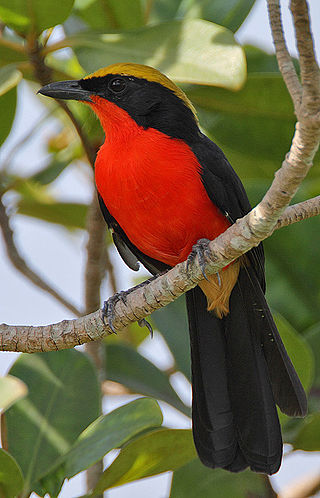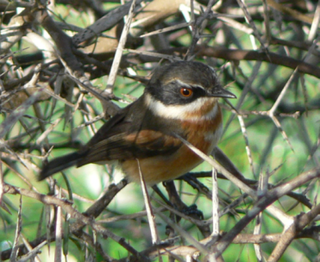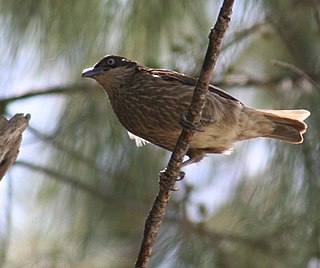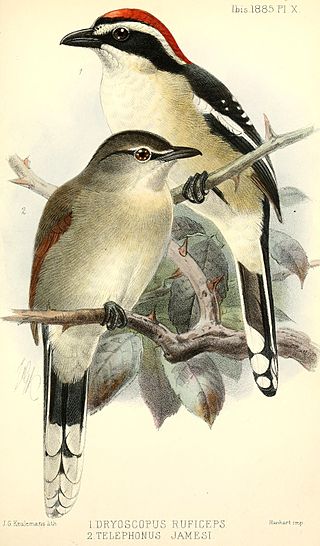
The lesser grey shrike is a member of the shrike family Laniidae. It breeds in South and Central Europe and western Asia in the summer and migrates to winter quarters in southern Africa in the early autumn, returning in spring. It is a scarce vagrant to western Europe, including Great Britain, usually as a spring or autumn erratic.

The long-tailed shrike or rufous-backed shrike is a member of the bird family Laniidae, the shrikes. They are found widely distributed across Asia and there are variations in plumage across the range. The species ranges across much of Asia, both on the mainland and the eastern archipelagos. The eastern or Himalayan subspecies, L. s. tricolor, is sometimes called the black-headed shrike. Although there are considerable differences in plumage among the subspecies, they all have a long and narrow black tail, have a black mask and forehead, rufous rump and flanks and a small white patch on the shoulder. It is considered to form a superspecies with the grey-backed shrike which breeds on the Tibetan Plateau.

The yellow-crowned gonolek, also known as the common gonolek, is a medium-sized passerine bird in the bushshrike family. It is a common resident breeding bird in equatorial Africa from Senegal and Democratic Republic of Congo east to Ethiopia. It is a skulking bird and frequents dense undergrowth in forests and other wooded habitats. The nest is a cup structure in a bush or tree in which two eggs are laid.

The black-headed bulbul is a member of the bulbul family, Pycnonotidae. It is found in forests in south-eastern Asia.

The gray kingbird or grey kingbird, also known as pitirre, petchary or white-breasted kingbird, is a passerine bird in the tyrant flycatchers family Tyrannidae. The species was first described on the island of Hispaniola, then called Santo Domingo, thus the dominicensis name.

The southern fiscal or fiscal shrike is a member of the shrike family found through most of southern Africa. It is also sometimes named jackie hangman or butcher bird due to its habit of impaling its prey on acacia thorns to store the food for later consumption. It was previously lumped together with the northern fiscal. Together they were known as the common fiscal.

The magpie tanager is a South American species of tanager. It is the only member of the monotypic genus Cissopis. As suggested by its common name, this blue-black and white species is superficially reminiscent of a European magpie. With a total length of 25–30 cm (9.8–11.8 in), a large percentage of which is tail, it is the longest species of tanager. It weighs 69–76 g (2.4–2.7 oz).

The Cape batis is a small, stout insect-eating passerine bird in the wattle-eye family. It is endemic to the Afromontane forests of southern Africa.

The red-capped lark is a small passerine bird that breeds in the highlands of eastern Africa southwards from Ethiopia and Somaliland. In the south, its range stretches across the continent to Angola and south to the Cape in South Africa.

The Cape grassbird or Cape grass warbler is an African warbler found in southern Africa. It is the only species placed in the genus Sphenoeacus.

The crimson-breasted shrike or the crimson-breasted gonolek,, or the crimson-breasted boubou, is a southern African bird. It has black upper parts with a white flash on the wing, and bright scarlet underparts. The International Union for Conservation of Nature has rated it as a "least-concern species".

Laniarius is a genus of brightly coloured, carnivorous passerine birds commonly known as boubous or gonoleks. Not to be confused with the similar-sounding genus Lanius, they were formerly classed with the true shrikes in the family Laniidae, but they and related genera are now considered sufficiently distinctive to be separated from that group as the bush-shrike family Malaconotidae.

The tropical boubou or bell shrike is a medium-sized passerine bird of sub-Saharan Africa. This very diverse "species" with its numerous subspecies and morphs has since long posed a taxonomic problem, and recent research suggests it is a cryptic species complex that has now been split into several species.

The Polynesian starling is a species of starling of the family Sturnidae. It is found in the Samoan Islands, Fiji, Niue, Tonga, the Santa Cruz Islands and Wallis and Futuna. Its natural habitats are subtropical or tropical dry forests and tropical moist forests. Various subspecies exist throughout this wide range, some darker in coloration and some lighter. Its call is a raspy buzz or rattle. Diet is fruit and insects.

The cliff flycatcher is a species of bird in the tyrant flycatcher family, Tyrannidae. The cliff flycatcher is the only species in the genus Hirundinea after the swallow flycatcher was merged, becoming subspecies Hirundinea ferruginea bellicosa. It is native to South America, where its natural habitats are cliffs and crags in the vicinity of subtropical or tropical dry forest, subtropical or tropical moist lowland forest, subtropical or tropical moist montane forest, and heavily degraded former forest.

The swamp boubou, also known as the Gabon boubou, is a species of bird in the Malaconotidae or bushshrike family. It is native to western and southern Central Africa. In the north of their range, savannah thickets constitute an important part of their habitat, while in the south they are strongly associated with river systems and marshes, for which they are named. The pair bond appears to be maintained by duetting, which in the south is generally synchronous or overlapping. It is most similar to L. major major, with which it perhaps hybridizes, but the underpart plumage is immaculate white, while the female contributes a ratchet-like note to the duet.

The red-naped bushshrike or red-naped boubou is a species of bird in the family Malaconotidae, which is native to the dry lowlands of the eastern Afrotropics.

The Jamaican becard is a species of bird in the family Tityridae. Its genus, Pachyramphus, has traditionally been placed in Cotingidae or Tyrannidae, but evidence strongly suggest it is better placed in Tityridae.

The Ethiopian boubou is a species of bird in the family Malaconotidae. It is found in Eritrea, Ethiopia, northwest Somalia, and northern Kenya. Its natural habitat is moist savanna.






















